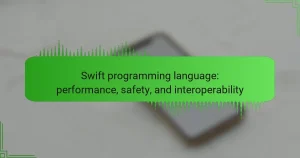Go is a statically typed, compiled programming language developed by Google, known for its simplicity, efficiency, and strong emphasis on concurrency. The language features a clean syntax that accelerates development and includes built-in garbage collection for easier memory management. Go’s concurrency model, utilizing goroutines and channels, allows multiple processes to execute simultaneously, making it particularly effective in cloud services and microservices architecture. With robust performance metrics, Go competes favorably against other languages, especially in networked applications, and is widely adopted by companies such as Google, Docker, and Kubernetes for backend systems. This article will explore Go’s concurrency model, its performance characteristics, and its applications in cloud services.

What is the Go programming language?
Go is a statically typed, compiled programming language designed for simplicity and efficiency. It was created at Google in 2007 and officially announced in 2009. Go emphasizes concurrency, allowing multiple processes to run simultaneously without conflict. Its syntax is clean and easy to read, which facilitates rapid development. The language includes built-in support for garbage collection, making memory management easier for developers. Go is widely used in cloud services and microservices architecture due to its performance and scalability. Its standard library provides extensive support for networking and web development. Many companies, including Google, Docker, and Kubernetes, utilize Go for their backend systems.
How does the Go programming language differ from other programming languages?
The Go programming language differs from other programming languages primarily through its concurrency model. Go utilizes goroutines, which are lightweight threads managed by the Go runtime. This allows for efficient handling of multiple tasks simultaneously. Other languages often rely on heavier threading models that can be more resource-intensive.
Additionally, Go features a simple syntax and strong static typing, which enhance code readability and maintainability. Many languages, such as Python or JavaScript, prioritize dynamic typing, which can lead to runtime errors.
Go’s built-in garbage collection also sets it apart. It automatically manages memory, reducing the risk of memory leaks common in languages like C or C++.
Furthermore, Go compiles to machine code, resulting in faster execution times compared to interpreted languages. This performance advantage is crucial in cloud services, where resource efficiency is vital.
Overall, Go’s unique attributes contribute to its effectiveness in developing scalable applications, particularly in cloud environments.
What are the key features of the Go programming language?
The key features of the Go programming language include simplicity, concurrency support, and strong performance. Go has a clean syntax that promotes readability and ease of use. It supports goroutines, enabling lightweight concurrent programming. Go’s built-in garbage collection helps manage memory efficiently. The language compiles to native code, enhancing execution speed. Go has a robust standard library that facilitates various tasks. It also features strong typing, which helps catch errors at compile time. Additionally, Go is designed for scalability, making it suitable for cloud services and distributed systems.
In what contexts is the Go programming language commonly used?
The Go programming language is commonly used in web development, cloud services, and microservices architecture. Its concurrency model makes it ideal for applications requiring high performance and scalability. Go is often employed in server-side applications, enabling efficient handling of multiple requests simultaneously. Additionally, it is widely used in DevOps tools and automation scripts. Companies like Google, Dropbox, and Docker utilize Go for its speed and simplicity. The language’s built-in support for concurrent programming allows developers to create responsive applications. Go’s performance is comparable to low-level languages like C, making it suitable for resource-intensive tasks.
Why is the Go programming language popular among developers?
The Go programming language is popular among developers due to its simplicity and efficiency. It features a clean syntax that allows for easy learning and rapid development. Go’s built-in support for concurrency enables developers to handle multiple tasks simultaneously with ease. This makes it particularly suitable for cloud services and distributed systems. Additionally, Go compiles to native code, resulting in high performance and low latency. Its comprehensive standard library provides essential tools for web development and networking. The language is also backed by strong community support and extensive documentation. These factors contribute to Go’s growing adoption in various industries.
What advantages does Go offer for software development?
Go offers several advantages for software development. Its concurrency model allows developers to efficiently manage multiple tasks simultaneously. This is achieved through goroutines, which are lightweight threads managed by the Go runtime. Go’s performance is comparable to that of lower-level languages like C, making it suitable for high-performance applications. Additionally, Go’s strong standard library supports web servers and cloud services, enhancing its usability in modern development environments. The language’s simplicity and readability facilitate easier maintenance and collaboration among developers. Furthermore, Go’s built-in garbage collection helps manage memory automatically, reducing the chances of memory leaks. These features collectively make Go a compelling choice for building scalable and efficient software solutions.
How does Go’s syntax contribute to its popularity?
Go’s syntax contributes to its popularity by offering simplicity and readability. The language uses a minimalistic approach, which reduces complexity. This makes it easier for developers to learn and adopt Go quickly. The clear structure of Go’s syntax promotes maintainability in codebases. Additionally, its strict formatting rules encourage consistency across projects. According to the 2021 Stack Overflow Developer Survey, Go ranks highly among developers for ease of use. This popularity is further supported by its growing community and extensive documentation. Overall, Go’s syntax is a key factor in its appeal to both new and experienced programmers.

What is the concurrency model in Go?
The concurrency model in Go is based on goroutines and channels. Goroutines are lightweight threads managed by the Go runtime. They allow functions to run concurrently, enabling efficient multitasking. Channels facilitate communication between goroutines. They provide a way to send and receive messages safely. This model simplifies concurrent programming. It avoids common pitfalls like race conditions. The Go concurrency model is designed for scalability and performance. It is particularly effective in cloud services, where handling multiple tasks simultaneously is crucial.
How does Go handle concurrency?
Go handles concurrency using goroutines and channels. Goroutines are lightweight threads managed by the Go runtime. They allow functions to run concurrently, enabling efficient multitasking. Channels facilitate communication between goroutines. They provide a way to synchronize data exchange without explicit locks. Go’s concurrency model is built around the CSP (Communicating Sequential Processes) paradigm. This model simplifies concurrent programming by avoiding shared state. The runtime scheduler efficiently manages goroutines, allowing thousands to run simultaneously. This design enhances performance, particularly in cloud services, by optimizing resource utilization.
What are goroutines and how do they work?
Goroutines are lightweight threads managed by the Go runtime. They enable concurrent execution of functions in Go programming. Each goroutine has a small stack, allowing thousands of them to run simultaneously. Goroutines communicate using channels, which provide safe data exchange. The Go scheduler manages goroutines, optimizing CPU usage and system resources. This model allows for efficient multitasking and improved performance in applications. Goroutines simplify concurrent programming by abstracting complex thread management. Their design is a core feature of Go, contributing to its popularity in cloud services and scalable applications.
What role do channels play in Go’s concurrency model?
Channels are a fundamental component of Go’s concurrency model. They facilitate communication between goroutines. Channels allow goroutines to send and receive values. This mechanism helps synchronize execution and share data safely. By using channels, developers can avoid race conditions. They provide a way to coordinate tasks without explicit locks. Channels can be buffered or unbuffered. Buffered channels allow for storing multiple values, enhancing performance in certain scenarios. Overall, channels simplify concurrent programming in Go by promoting a clear communication pattern.
Why is the concurrency model important for performance?
The concurrency model is crucial for performance because it enables efficient execution of multiple tasks simultaneously. In the Go programming language, this model utilizes goroutines and channels to manage concurrency. Goroutines are lightweight threads that allow for high scalability. They enable developers to run thousands of concurrent operations without significant overhead. This leads to better resource utilization and faster execution times.
Additionally, the model minimizes the complexity of managing concurrent operations. It abstracts away lower-level thread management, making it easier for developers to implement concurrent logic. Studies show that applications designed with Go’s concurrency model can handle more requests per second compared to traditional threading models. This efficiency is particularly beneficial in cloud services, where performance and scalability are critical.
How does Go’s concurrency model compare to traditional threading models?
Go’s concurrency model uses goroutines, which are lightweight and managed by the Go runtime. Traditional threading models rely on operating system threads that are heavier and managed by the OS. Goroutines allow thousands of concurrent operations without significant overhead. In contrast, traditional threads can lead to high memory consumption and context-switching costs.
Go’s channels facilitate communication between goroutines, promoting safe data sharing. Traditional models often require locks and condition variables, which can lead to complex code and potential deadlocks. The Go model emphasizes simplicity and ease of use, making concurrent programming more accessible.
As a result, Go’s concurrency model is more efficient for handling high concurrency levels compared to traditional threading models. This efficiency is particularly beneficial in cloud services, where scalability is crucial.
What are the benefits of using Go’s concurrency model in applications?
Go’s concurrency model provides several benefits for applications. It simplifies concurrent programming through goroutines. Goroutines are lightweight threads managed by the Go runtime. This allows developers to create thousands of concurrent tasks without significant overhead.
The model uses channels for communication between goroutines. Channels ensure safe data exchange and synchronization. This reduces the complexity associated with traditional locking mechanisms.
Go’s concurrency model enhances performance in I/O-bound applications. It allows better utilization of resources by handling multiple tasks simultaneously. According to benchmarks, Go applications can handle high levels of concurrency efficiently.
Overall, Go’s concurrency model leads to more scalable and maintainable applications. It empowers developers to write clean and efficient concurrent code.

How does performance in Go compare to other languages?
Go programming language performs competitively against other languages in terms of speed and efficiency. It is designed for high concurrency, which enhances its performance in multi-threaded environments. Go’s garbage collection is optimized for low latency, contributing to faster execution times. Benchmarks show that Go often outperforms languages like Python and Ruby, especially in networked applications. In comparison to C and C++, Go may be slower due to its higher-level abstractions. However, Go’s simplicity and built-in concurrency features often lead to faster development cycles. Overall, Go’s performance is robust, making it suitable for cloud services and scalable applications.
What factors influence the performance of Go applications?
The performance of Go applications is influenced by several factors. These include the efficiency of the garbage collector, which impacts memory management. The design of concurrent processes also plays a crucial role. Go’s goroutines allow for lightweight thread management, enhancing performance in concurrent tasks. Additionally, the choice of data structures affects speed and memory usage. Compiled code execution speed is another significant factor. The use of efficient algorithms can further optimize performance. Network latency and I/O operations also contribute to overall application performance. Finally, hardware specifications can limit or enhance the performance capabilities of Go applications.
How does memory management affect performance in Go?
Memory management significantly affects performance in Go. Go uses a garbage collector for automatic memory management. This can introduce latency during program execution. The garbage collector periodically pauses the application to reclaim unused memory. These pauses can impact the responsiveness of applications, especially in high-concurrency scenarios. Efficient memory allocation reduces the frequency of garbage collection. Go’s design aims to optimize memory usage, minimizing overhead. Benchmarks show that well-managed memory can lead to better throughput and lower latency in Go applications.
What tools are available for measuring Go performance?
Go performance can be measured using several tools. Popular options include pprof, which provides profiling for CPU and memory usage. Another tool is Go test, which can benchmark functions within Go code. Additionally, trace tool helps visualize goroutine execution over time. Benchstat is useful for analyzing benchmark results. Lastly, metrics libraries like Prometheus can monitor application performance in real-time. These tools are widely adopted in the Go community for effective performance assessment.
How can developers optimize performance in Go?
Developers can optimize performance in Go by using goroutines and channels effectively. Goroutines allow concurrent execution of functions, reducing execution time. Channels facilitate communication between goroutines, enhancing synchronization.
Utilizing the Go profiler can identify bottlenecks in code. This tool helps in analyzing CPU and memory usage. Developers should also minimize memory allocations to improve garbage collection efficiency.
Implementing efficient data structures, like slices and maps, can enhance performance. Choosing the right algorithms also plays a critical role in execution speed.
Finally, developers should leverage Go’s built-in concurrency patterns for scalable applications. These practices collectively improve the overall performance of Go applications.
What best practices should be followed for performance tuning in Go?
To achieve optimal performance tuning in Go, follow these best practices: Use Go’s built-in profiling tools to identify bottlenecks. The pprof tool allows for CPU and memory profiling. Optimize memory allocation by minimizing garbage collection. Use sync.Pool for managing temporary objects. Leverage goroutines effectively to enhance concurrency. Limit the number of goroutines to prevent excessive context switching. Utilize efficient data structures like slices and maps for performance gains. Lastly, compile with optimization flags, such as -O2, for better execution speed. These practices are supported by Go’s design principles, which focus on performance and concurrency efficiency.
What role does Go play in cloud services?
Go plays a significant role in cloud services by enabling efficient concurrency and performance. Its goroutines allow developers to handle multiple tasks simultaneously without the overhead of traditional threading models. This capability is essential for cloud applications that require high scalability and responsiveness. Go’s simplicity and speed contribute to faster development cycles, making it ideal for cloud-native applications. Additionally, its strong support for networking and HTTP servers facilitates the creation of microservices architecture. Companies like Google, Dropbox, and Docker utilize Go for their cloud services, demonstrating its effectiveness in real-world applications.
How is Go utilized in cloud-native applications?
Go is utilized in cloud-native applications primarily for its concurrency model and performance. The language’s goroutines allow for efficient handling of multiple tasks simultaneously. This feature is particularly beneficial in microservices architectures, where independent services communicate over networks. Go’s lightweight nature reduces resource consumption, making it ideal for cloud environments. Furthermore, its built-in support for HTTP servers simplifies the development of web services. Go’s standard library includes packages for JSON handling and HTTP requests, streamlining cloud application development. The language’s compilation to machine code enhances execution speed, which is crucial for scalable cloud services. Additionally, Go’s static typing and simplicity improve maintainability, which is essential for evolving cloud applications.
What are the advantages of using Go for cloud services?
Go offers several advantages for cloud services. Its concurrency model simplifies the development of scalable applications. Goroutines allow developers to run multiple tasks simultaneously with minimal overhead. This leads to efficient resource utilization in cloud environments. Go’s performance is comparable to lower-level languages like C. This ensures faster execution times for cloud applications. Additionally, Go’s strong standard library supports various cloud protocols. This includes HTTP, gRPC, and others, making integration seamless. The language’s simplicity enhances maintainability and reduces development time. This is crucial for rapidly evolving cloud technologies. Overall, Go’s design aligns well with the demands of cloud services.
What are some practical tips for using Go in cloud environments?
Use Go’s built-in concurrency model to handle multiple tasks efficiently in cloud environments. This allows for the creation of lightweight goroutines that can run concurrently. Leverage channels for safe communication between goroutines. This promotes data integrity and reduces the risk of race conditions. Optimize your application by minimizing memory allocations. Go’s garbage collector can impact performance if overused. Utilize Go modules for dependency management. This simplifies version control and enhances reproducibility in cloud deployments. Implement logging and monitoring to track application performance. This helps identify bottlenecks and optimize resource usage. Consider using containerization with Docker. It ensures consistent environments across development and production.
The Go programming language, developed by Google, is recognized for its simplicity, efficiency, and robust concurrency model that utilizes goroutines and channels. This article explores Go’s unique attributes, including its performance advantages in cloud services and microservices architecture, and how its clean syntax enhances code readability and maintainability. Key features such as built-in garbage collection, strong static typing, and a comprehensive standard library are discussed, highlighting Go’s suitability for scalable applications. Additionally, the article examines the importance of Go’s concurrency model in optimizing performance and resource utilization in cloud environments.


